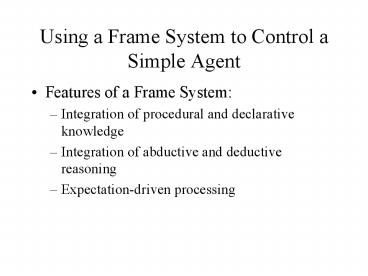Using a Frame System to Control a Simple Agent PowerPoint PPT Presentation
1 / 7
Title: Using a Frame System to Control a Simple Agent
1
Using a Frame System to Control a Simple Agent
- Features of a Frame System
- Integration of procedural and declarative
knowledge - Integration of abductive and deductive reasoning
- Expectation-driven processing
2
A Simple Perceive-Act Agent
- The agents simple environment
Exit door
Food Trap
Entrance door
This is the physical layout of a room, with 2
doorways, food, and a trap. The agent is depicted
by the arrow, which indicates the agents
orientation.
This is the agents perception of the
environment. Some edges are occluded from view.
3
The Agents Frame System
- The agent has a frame for each distinctive place
in the environment at-entrance, at-food,
at-trap, and at-exit - Each frame encodes the agents perception,
expectations, and actions - The at-entrance frame
- Percepts
4
The at-entrance Frame
- Percepts
- Expectations
- Action Move-Through-Room
- at-entrance --move-to-food --gt at-food
--eat-food--gt satiated --move-to-exit--gt at-exit
The agent expects that the trap is left of the
food (based on previous experiences). In reality,
this time, the food and the trap are reversed
from this expected arrangement (see slide 2).
Dashed red lines indicate expectations
5
1st Iteration of the Perceive-Act Loop
- The agent propagates its perception of the
environment to all the frames in the frame
system. It is compared with the percepts recorded
in each frame of the frame system. - The best matched frame is at-entrance
- The agent executes the action move-through-room.
After the first action, move-to-food, the agent
expects to be at-food
6
Expectation Violation !
- The agent perceives
- The agent expects to perceive (based on the
at-food frame) - This triggers (indexes) the at-trap frame
7
Using the at-trap Frame
We'll assume the action sequence for at-trap is
at-trap ? circle around it ?go to exit
Note when operating with this frame, the agent
cares only about the environment near the trap
that part of the environment outside the oval is
ignored.
The agent's expectations in this frame are given
by this diagram
Note the circle indicates the agent's travel.
The edges (of the trap) indicate what the agent
expects to perceive during this travel.
Following the action sequence, the agent goes to
the exit.

